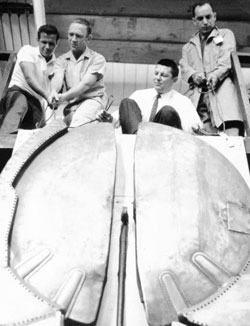Landmarks: The First Million-Volt Accelerator

APS has put the entire Physical Review archive online, back to 1893. Focus Landmarks feature important papers from the archive.
Physicists learned most of what they know about the fundamental forces of nature by using larger and larger accelerators to smash subatomic particles together. The era of the modern particle accelerator began in 1932, when Ernest O. Lawrence and M. Stanley Livingston of the University of California at Berkeley published their design in the Physical Review. Their machine, the cyclotron, revs up protons by giving them repeated boosts as they travel around on a spiral path. The basic cyclotron concept remains even in the largest accelerator on earth, the 27-kilometer-circumference machine currently under construction outside Geneva.
To break atoms and nuclei into their smallest bits, physicists have always sought to blast them with the fastest-moving particles they could get their hands on. They measure the energy of these particles in electron-volts: An electron pulled from a standing start to a metal plate held at 12 volts accelerates to an energy of 12 electron-volts. During the 1920s several physicists used scaled-up versions of this process to generate protons of about a million electron-volts. But these methods were unwieldy, and going to higher energies presented new problems.
Lawrence and Livingston, his graduate student, had the idea of pushing particles to higher energies by making them travel in circles. They mounted two flat, semicircular metal chambers between the faces of a powerful electromagnet. The chambers were shaped like the two halves of a cookie sliced down the middle and became known as “dees” because of the letter they resembled. The team applied opposite and alternating voltages to the dees, so that whenever one was positive the other was negative. The voltage difference pulls a charged particle into one of the dees, where the magnetic field forces it onto a curved path that slings it back to the other dee, by which time the voltages have reversed.
In this way, particles loop back and forth, gaining energy at each passage. The faster they move, the larger the arc they follow through each dee. Luckily, the time they spend in each semicircle remains the same, so that Lawrence and Livingston could use a fixed frequency for the oscillating voltage without getting “out of step” with the particles.
Crucial to the device’s success was another stroke of luck. The electric and magnetic fields inside the cyclotron tend to “focus” any straying particles back toward the central plane of the device, keeping them in a tight beam. In a cyclotron 28 centimeters across, Lawrence and Livingston got protons to circulate more than 300 times by applying an oscillating 4,000 volts; the protons emerged with better than a million electron-volts of energy, according to the 1932 paper. (In 1931 the team had reported a smaller cyclotron that demonstrated the principle [1]).
The principle of the cyclotron fails as particles accelerate close to the speed of light. Relativity theory comes into play, and the time a particle would spend in each dee as it accelerates is no longer fixed. The 1940s invention of the synchrotron solved this problem by continually adjusting the frequency. But the cyclotron was “the first major workhorse” of particle physics, says Robert Crease of the State University of New York at Stony Brook, and its central principle of getting large energies from modest voltages survives in all modern synchrotrons.
–David Lindley
David Lindley is a freelance science writer in Alexandria, Virginia.
References
- E. O. Lawrence and M. S. Livingston, “The Production of High Speed Protons Without the Use of High Voltages,” Phys. Rev. 38, 834 (1931) is a half-page letter reporting a smaller cyclotron
More Information
web exhibit on “Lawrence and the Cyclotron” from the Physics History Center at the American Institute of Physics


